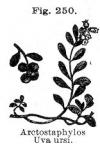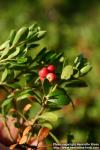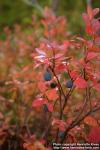
 Preparations: Extract of Uva Ursi
- Fluid Extract of Uva Ursi
Preparations: Extract of Uva Ursi
- Fluid Extract of Uva Ursi
The leaves of Arctostaphylos Uva ursi (Linné), Sprengel"—(U. S. P.) (Arbutus Uva ursi, Linné; Arctostaphylos officinalis, Wimmer).
Nat. Ord.—Ericaceae.
COMMON NAMES: Bearberry, Upland cranberry.
ILLUSTRATION: Bentley and Trimen, Med. Plants, 163.
Botanical Source.—This plant is a small, perennial shrub, having a long, fibrous root. Its stems are woody, trailing, and rooting, the young shoots only turning upward; the bark deciduous and smooth. The leaves are alternate, obovate, acute at base, short petioled, coriaceous, evergreen, glabrous, shining above, paler beneath, entire, in young ones pubescent, the margin rounded, but scarcely reflexed. The flowers are terminal and clustered. Peduncles short, red, reflexed, and furnished at base with a short, acute bract, with 2 minute ones at the sides. Sepals 5, roundish, reddish, and persistent. Corolla ovate or urceolate, white with a reddish tinge, transparent at base, contracted at the mouth, and hairy inside, with 5 short, reflexed segments. Stamens 10, very slightly adhering to the base of the corolla; filaments hairy; anthers reddish, each with 2 horns and 2 pores. Ovary round; style straight, longer than the stamens; stigma simple. Disk a black indented ring. The fruit is small, globular, succulent, drupaceous, depressed, almost scarlet-colored, with an insipid, mealy pulp, and 5 angular seeds (L.).
History and Description.—Uva ursi is a perennial evergreen, common in the northern part of Europe and America, growing on sterile, gravelly ridges, and dry, sandy soils. It flowers from June to September, and ripens its berries during the winter. The leaves are the parts used; the green leaves alone should be selected, picked from the twigs in the fall, and dried by exposure to a moderate heat. They are frequently adulterated with whortleberry or cowberry leaves. These adulterations may be detected by observing that the uva ursi leaf is reticulated beneath, while the whortleberry leaf is merely dotted. The leaves of pipsissewa are longer, cuneate-lanceolate, and sharply serrated, Uva ursi leaves are odorless, except when in powder, which is of a light-brown color, with a shade of greenish-yellow, and has nearly the smell of good grass hay, and to the taste is at first smartly astringent and bitterish, which sensations gradually soften into a liquorice flavor. The leaves yield their properties to water or alcohol, forming, with the latter, a green tincture, which is rendered turbid by water, causing a deposit of green resin. As officially described, uva ursi leaves are "very short-stalked, obovate or oblong-spatulate, coriaceous, from 15 to 20 Mm. (⅗ to ⅘ inch) long, and 5 to 8 Mm. (⅕ to ⅓ inch) broad, obtuse, slightly revolute on the margin, upper surface with depressed veins; lower surface distinctly reticulate; odor faint, hay-like; taste strongly astringent, and somewhat bitter"—(U. S. P.).
Chemical Composition.—The leaves of uva ursi contain large quantities of gallic acid. The active principle is the crystallizable glucosid, arbutin, announced by Kawalier, in 1852. Previously, J. C. C. Hughes (Amer. Jour. Pharm., 1847, p. 88) attributed the diuretic power of the leaves to a crystallizable substance, which he called ursin. This substance was subsequently shown by Jungmann (ibid., 1871, p. 205) to have been arbutin mixed with some gallic acid. Diluted acids, as well as the ferment emulsin, decompose arbutin into sugar, hydroquinone (C6H6O2) (arctuvin of Kawalier), and methyl-hydroquinone (C6H5[CH3]O2), which substances may occur in the herb together with arbutin. Upon destructive distillation of an extract of uva ursi leaves, hydroquinone can be isolated from the distillate (Uloth, 1859). Other constituents of the leaves are the bitter glucosid ericolin, and its decomposition product ericinol (Rochleder and Schwarz, 1852, and R. Thal, Pharm. Zeitschr. für Russland, 1883, p. 209; also see Rhododendron, Ledum, etc.); the crystallizable substance urson, insoluble in water (H. Trommsdorff, 1854); tannic and malic acids, a small quantity of volatile oil, fatty matter, wax, gum, sugar, coloring matter, (etc. (Jungmann, loc. cit.). A yellow coloring matter, allied to quercetin, of the formula C15H10O7, was isolated by A. G. Perkin (see Amer. Jour. Pharm., 1898, p. 584). It forms phloroglucin and protocatechuic acid upon fusion with alkali. The ash of the leaves of uva ursi amounts to about 3 per cent. The leaves are free from the poisonous andromedotoxin, which occurs in certain other Ericaceae.
ARBUTIN (C25H34O14, Hlasiwetz and Habermann, 1883) also occurs in other Ericaceae (see Pyrola, Kalmia, Gaultheria, etc.) From the leaves of uva ursi it is obtained by adding solution of subacetate of lead to a decoction of the leaves, removing the lead from the filtrate by sulphide of hydrogen, and evaporating to crystallization. The crystals are purified by treatment with a mixture of ether (8 parts) and alcohol (1 part), and are subsequently crystallized from water. It forms colorless, long, silky needles of bitter taste, neutral reaction, very hygroscopic, easily soluble in hot water and alcohol, hardly soluble in ether. The aqueous solution produces a blue color with ferric chloride, and does not reduce Fehling's solution, nor is it precipitated by the lead acetates. Acids and emulsin decompose it as stated before. In aqueous solution, rendered alkaline by ammonia or caustic potash, arbutin acquires a deep azure-blue color with phosphomolybdic acid (Jungmann, loc. cit.)
Action, Medical Uses, and Dosage.—The effects of this medicine depend entirely on its stimulant, astringent, and tonic powers, though, in the smaller doses, it tends to relieve chronic irritation of the bladder. As an astringent, it is applicable to all the purposes for which astringents are used, as in chronic diarrhoea and dysentery, menorrhagia, diabetes, enuresis, etc. In chronic a affections of the kidneys and urinary passages, it is frequently useful; in vesical catarrh, chronic gonorrhoea, strangury, leucorrhoea, and excessive mucous and bloody discharges with the urine. Its tannic acid becomes oxidized and converted into gallic and pyrogallic acids, and humus-like substances, which communicate a dark color to the urine. The keynote to its use is relaxation of the urinary membranes, as is evidenced by catarrhal discharges and a feeling of weight and dragging in the loins and perineum. There is always a feeble circulation and lack of innervation in the urinary tract when uva ursi is indicated. It undoubtedly lessens lithic acid deposits in the urine. In gonorrhoea, with bloody and mucous discharges, and pain in the vesical region, it speedily allays all these unpleasant symptoms. Cystic spasm is relieved by it, and, when calculi are present, it obtunds the cystic membranes to such an extent that the offending material is comfortably borne. It is also a remedy for passive hemorrhage, small in amount, and in chronic affections of the larynx, bronchiae, and pulmonary tissues, with excretion and cough. In large doses, uva ursi may cause emeto-catharsis. Arbutin, while undoubtedly diuretic, does not fully represent uva ursi, and the latter is said not to exert a diuretic action in health. Arbutin, in its passage through the system, is decomposed, and gives rise to hydroquinone, to which body has been attributed the retardation of putrescent changes in the urine of persons taking uva ursi. Arbutin may be given to the extent of 10 or 15 grains a day, usually mixed with sugar. Dose of powdered uva ursi, 10 to 60 grains; of the decoction, 1 to 3 fluid ounces, made by boiling 1 ounce of uva ursi with 1 ½ pints of distilled water down to 1 pint; of the extract, 5 to 15 grains; of the tincture, 6 to 30 drops.
Specific Indications and Uses.—Relaxation of the urinary tract, with pain and mucous or bloody secretions; feeling of weight and dragging in the loins and perineum, when not due to prostatic enlargement; chronic vesical irritation, with pain, tenesmus, and catarrhal discharges.
 Related Species and Sophistications.—The leaves of the following North American plants have been used as substitutes or adulterants of uva ursi: Vaccinium uliginosum, Linné, Bog-bilberry; Vaccinium Vitis-idaea, Linné, Cowberry, or Red whortleberry (containing vacciniin [arbutin]; see E. Claassen, Amer. Jour. Pharm., 1870, p. 297; and F. Oelze, Jahresb. der Pharm., 1890, p. 73); Buxus sempervirens, Linné, Box; Leiophyllum buxifolium, Elliott; Oxydendron arboreum, De Candolle, Sourwood, or Sorrel tree; and Epigae repens, or Trailing arbutus, containing ericolin and, probably, arbutin. Other species related to uva ursi are:
Related Species and Sophistications.—The leaves of the following North American plants have been used as substitutes or adulterants of uva ursi: Vaccinium uliginosum, Linné, Bog-bilberry; Vaccinium Vitis-idaea, Linné, Cowberry, or Red whortleberry (containing vacciniin [arbutin]; see E. Claassen, Amer. Jour. Pharm., 1870, p. 297; and F. Oelze, Jahresb. der Pharm., 1890, p. 73); Buxus sempervirens, Linné, Box; Leiophyllum buxifolium, Elliott; Oxydendron arboreum, De Candolle, Sourwood, or Sorrel tree; and Epigae repens, or Trailing arbutus, containing ericolin and, probably, arbutin. Other species related to uva ursi are:
Arctostaphylos glauca, Lindley, Manzanita.—California. This shrub-like tree grows in the dry, rocky districts of the Sierras, on the western slopes. The leaves are the parts used, being employed like uva ursi. They are about 2 inches long, leathery, entire, ovate-oblong, and of a light-green hue. J. H. Flint (Amer. Jour. Pharm., 1873, p. 197) found in them nearly 10 per cent of tannin and some arbutin, which gave Jungmann's test (see Uva Ursi).
Arbutus xalapensis, Kunth, Mexico and western Texas, and Arctostaphylos tomentosa, Douglass, of Mexico, both known as Madrona, are used like uva ursi; as are also the Arctostaphylos mucrocifera, De Candolle, and the Arctostaphylos polifolia.

